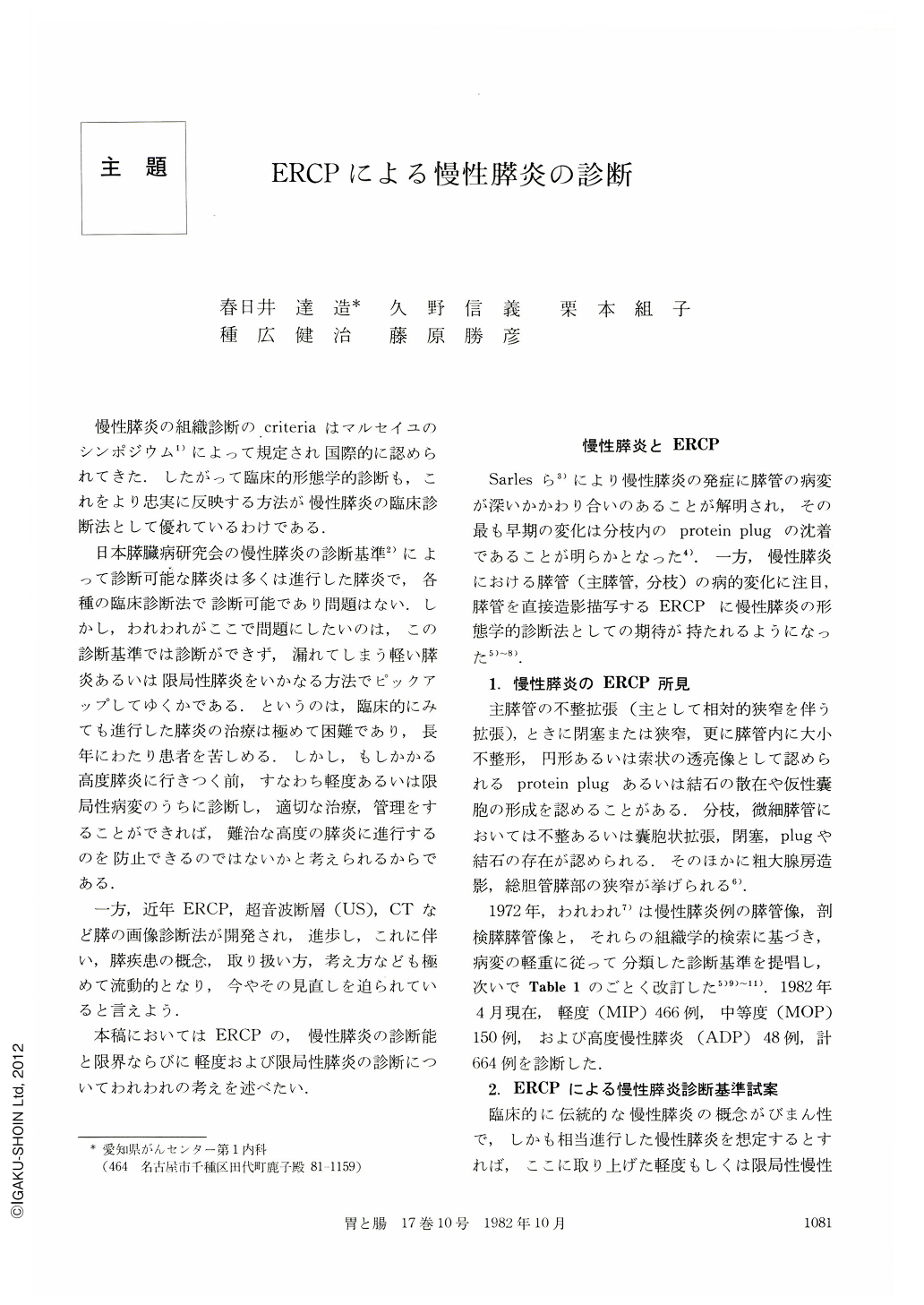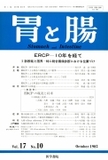Japanese
English
- 有料閲覧
- Abstract 文献概要
- 1ページ目 Look Inside
慢性膵炎の組織診断の.criteriaはマルセイユのシンポジウム1)によって規定され国際的に認められてきた.したがって臨床的形態学的診断も,これをより忠実に反映する方法が慢性膵炎の臨床診断法として優れているわけである.
日本膵臓病研究会の慢性膵炎の診断基準2)によって診断可能な膵炎は多くは進行した膵炎で,各種の臨床診断法で診断可能であり問題はない.しかし,われわれがここで問題にしたいのは,この診断基準では診断ができず,漏れてしまう軽い膵炎あるいは限局性膵炎をいかなる方法でピックアップしてゆくかである.というのは,臨床的にみても進行した膵炎の治療は極めて困難であり,長年にわたり患者を苦しめる.しかし,もしかかる高度膵炎に行きつく前,すなわち軽度あるいは限局性病変のうちに診断し,適切な治療,管理をすることができれば,難治な高度の膵炎に進行するのを防止できるのではないかと考えられるからである.
Purpose of this study is to establish criteria for diagnosis of chronic pancreatitis by ERCP.
Correlation between pancreatograms and their histologies were studied by means of a selective section method followed by making serial preparations in surgically resected pancreases and postmortem pancreases, and it was evidenced that irregularly dilated branches on pancreatogram indicate an existence of inflammatory changes in their drainage lobuli.
Criteria for ERCP diagnosis of chronic pancreatitis are drawn up and proposed according to above evidence.
We proposed criteria for diagnosis of chronic pancreatitis on ERCP as follows; definitive findings of chronic pancreatitis on ERCP are irregular dilatation of the pancreatic ducts (the main pancreatic duct, the branches and fine pancreatic ducts) and calculi. Irregular dilatation means dilatation accompanying stenosis (mainly relative stenosis).
Other findings are plug, cyst, obstruction and/or stenosis of the pancreatic ducts, coarse acinar opaci-fication and stenosis of the pancreatic portion of the common bile duct.
Findings of chronic pancreatitis on ERCP should be evaluated and described about distribution, location and degree of the findings as follows; distribution of the findings can be listed as diffuse (D) or localized such as segmental (S), focal (F) and multi-focal (MF). Location of localized findings are described as head (H), body (B), tail (T) and their combination. Minimal (I), moderate (II) and marked (III) represent degree of findings.
Description of evaluated findings can be represented with combination of their abbreviations.
Evaluations of findings on ERCP are as follows; (1) Markedly irregular dilatation of the pancreatic ducts and calculi can be listed as marked lesion, and irregular dilatation of the ducts with obstruction or cyst of the main pancreatic duct, or with extensive coarse acinar opacification is also listed as marked lesion. (2) Minimal or moderate irregular dilatation of the main pancreatic duct is listed as moderate lesion, and accompanying moderate irregular dilatation of the branches can make the evaluation more accurate. (3) Minimal irregular dilatation of the branches and fine pancreatic ducts without irregular dilatation of the main pancreatic duct should be listed as minimal lesion. Other findings without definitive findings should be considered as suspicious lesion of chronic pancreatitis.
Therefore, severity of chronic pancreatitis can be classified into advanced, moderate and minimal pancreatitis based upon topographic distribution and degree of the lesion on ERCP.
Focal minimal pancreatitis consisted of focal or multi-focal lesions seen pancreatographically is proposed as a new clinical entity separated from conventional chronic pancreatitis.
A correct ERCP diagnosis could make possible appropriate management even for minimal or localized pancreatitis and progression from minimal or localized pancreatitis to advanced pancreatitis might be prevented.

Copyright © 1982, Igaku-Shoin Ltd. All rights reserved.


